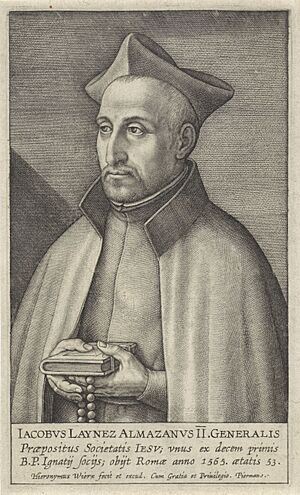Diego Laynez facts for kids
Several spellings of his names (James, Jacob; Laines, Laynez, Lainez) are in use and some of them can be found in other Wikipedia articles
Diego Laynez (sometimes spelled Laínez) was an important Spanish Jesuit priest and theologian. He was born in Almazán, Spain, in 1512 and passed away in Rome on January 19, 1565. He became the second leader of the Jesuit order.
Contents
Early Life and Joining the Jesuits
Diego Laynez grew up in Almazán in Castile, Spain. He studied at the University of Alcalá and later continued his education in Paris. There, he met Ignatius of Loyola, who would become the founder of the Jesuits.
Laynez was one of the first seven men who joined Ignatius to form the original group called the Friends in the Lord. This group later became known as the Society of Jesus, or the Jesuits. They made promises to live simply and help others, and they hoped to travel to Jerusalem.
However, they couldn't find a ship to the Holy Land. So, Laynez and the other nine "Friends in the Lord" offered their help to the Pope. After the Jesuit order was officially started in 1540, Laynez went on several missions, including visiting Germany. He also taught scholastic theology at the La Sapienza university in Rome.
Working at the Council of Trent
Diego Laynez played a very important role at the Council of Trent. This was a major meeting of Catholic Church leaders that took place over many years to discuss and reform the Church. Laynez was a special advisor to the Pope during all three main periods of the Council.
First Period of the Council
Laynez arrived at Trent in May 1546, a few months after the Council began. He quickly became known for his intelligence and speaking skills. He was even allowed to preach in Trent when he wasn't busy with Council matters, which was unusual for advisors. He was also given three hours to speak during debates, while others usually only had one.
One of his most famous speeches was about how people become "just" or righteous in God's eyes. He argued against a theory that suggested a "double justice." His arguments helped shape the Council's official teaching on this topic in January 1547.
After this, Laynez helped prepare important documents about the sacraments, which are special religious ceremonies like baptism. He worked with another Jesuit, Alfonso Salmeron, to list Protestant ideas about sacraments and summarize Church teachings. This research helped the Council make decisions about sacraments in March 1547.
The Council later moved to Bologna, where Laynez continued his work on sacraments like the Eucharist and penance. He left Bologna in June 1547 because the work was moving too slowly. Between the first and second periods of the Council, he helped reform convents and dioceses, and he preached in different cities.
Second Period of the Council
Laynez returned to Rome in November 1550 to get ready for the second period of the Council of Trent, which started in May 1551. He arrived at Trent in July and quickly contributed to discussions about the Eucharist. His arguments helped lead to the Council's decree on the Sacrament of the Eucharist in October.
He also started preparing for discussions on penance and extreme unction (anointing of the sick). Laynez often got sick during this time, but he recovered and gave another long speech in December about the Mass as a sacrifice. The Council was paused again in April 1552.
When Ignatius of Loyola died in 1556, Diego Laynez temporarily led the Jesuit Society. Because of some challenges and difficulties with Pope Paul IV, the meeting to choose a new leader was delayed for two years. When it finally happened in July 1558, Laynez was chosen on the very first vote. He became the second Superior General of the Jesuits.
Third Period of the Council
In 1560, as the new Jesuit General, Diego Laynez strongly argued that the Council of Trent should continue until it finished its work. This was against the wishes of Emperor Ferdinand I, who wanted a new council to start. Pius IV agreed with Laynez, and the Council reopened in January 1562.
When Laynez arrived back at Trent in August 1562, he defended the practice of giving Communion under only one kind (bread, not wine). He also gave speeches arguing that the Pope's authority was very important and that bishops received their power through the Pope. He made one small theological mistake when he doubted the Church's power to make secret marriages invalid, but the Council later corrected this.
After Pope Paul IV died, many cardinals wanted to elect Laynez as the new Pope. However, he avoided them because he did not want to become Pope.
Death and Lasting Impact
Diego Laynez passed away in Rome on January 19, 1565. He was first buried in the Roman church of the Madonna Della Strada, which was later rebuilt into the Church of the Gesù. His remains were moved to Madrid in 1667 and then to other churches over the years.
Laynez was very important in making education a central part of the Jesuit order's identity. He realized there weren't enough teachers, so he decided that schools should be the most important work of the Jesuits. He made a rule that almost every Jesuit must teach at some point in their career.
He explained that helping people through teaching in schools was as important as all the other Jesuit ministries combined, like preaching or hearing confessions. This decision shaped the careers of almost all future Jesuits and made education a key part of the Jesuit mission around the world.
Writings
- LAYNEZ, Diego, Lainii Monumenta: Epistolae et Acta (8 volumes), IHSI, Madrid, 1912–17.
- His Disputationes Tridentinae were published in 2 volumes in 1886.
See also
 In Spanish: Diego Laínez (jesuita) para niños
In Spanish: Diego Laínez (jesuita) para niños


